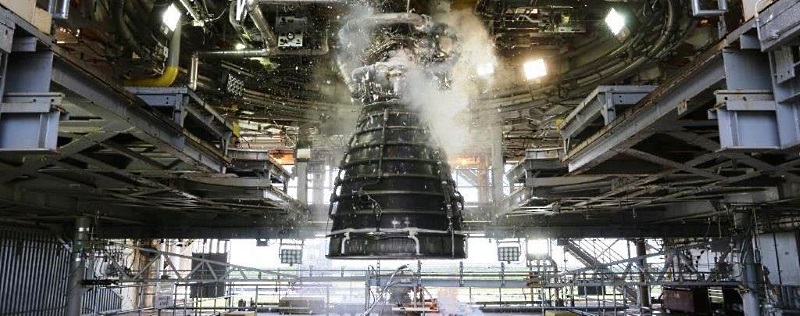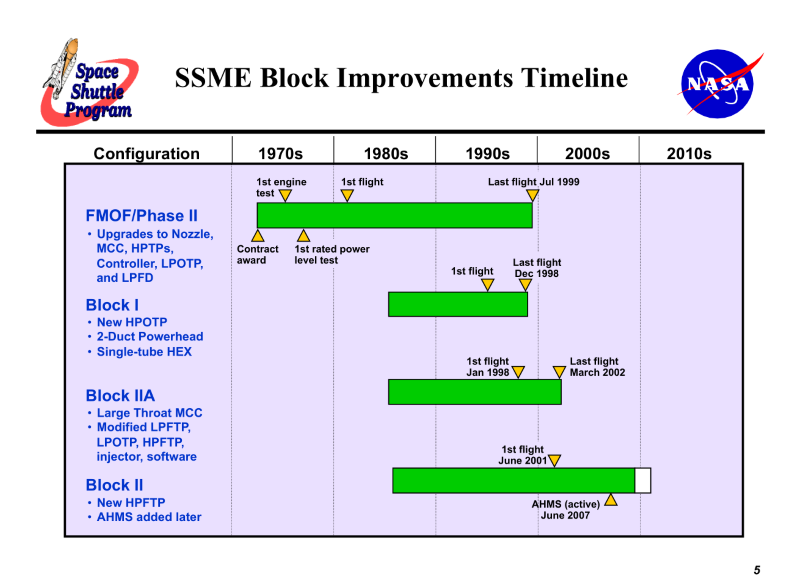Engine life after the death of the rocket
Space shuttles stopped flying almost exactly seven years ago, but their SSME (RS-25) engines were prepared for a longer life. Now they are actively tested under different names for two projects, and in one case they are modified for single use, and in the other, on the contrary, they check that the engines have retained the ability to go into space again with minimal delays.

Engine tests based on SSME, NASA photo
Sixteen SSME engines left the shuttle. This is enough for four flights of the super-heavy SLS rocket (there are four engines on the second stage), but new ones will be required for subsequent launches. Therefore, in 2015, Aerojet Rocketdyne received a contract to resume production. At the same time, the testing of engines adapted for a new rocket from the warehouse began. And from the end of 2017, they started to test modifications for new engines.
The main difference between the new RS-25 will be increased traction. At the end of the shuttle operation, the engines operated at 104.5% of the original thrust. For adapted engines from the warehouse, it has already been increased to 109%, and if in 2017 it was plannedadd 2 percent, then in February of this year, the test engine "dispersed" to 113% of the original thrust. In addition, new parts are being gradually introduced to the RS-25.
At stage 1A, a new pogo-oscillation damper , produced by selective laser sintering on a 3D printer, was installed on the engine . Printing a complex-shaped part will be cheaper than manufacturing using the methods previously used.
Stage 1B is expected to begin on August 4, and 9 new parts will be tested, including a new combustion chamber made by hot isostatic pressing and cheaper insulation of a high-pressure fuel pump.

New insulation - silver coating on the left. NASA Photos
The main change to stage 2 will be simple corrugated pipelines instead of complex flexible joints. Unlike the shuttle, the SLS engines will turn less in flight, which simplifies the design.
And at stage 3, the nozzle, which was previously made of 37 parts, will be replaced with a new one, assembled from only four.

Making a new nozzle, a NASA photo.
As a result, in addition to increasing the thrust, the engine should be noticeably cheaper, because the new components are expected to cost 20-60% less.

Savings on new parts, NASA illustration.
Under the terms of the contract, six new engines must be transferred to NASA in July 2024.
The XSP experimental space plan (or more recently XS-1) is a DARPA project to create a launch vehicle with a winged, reusable first stage.
A single SSME was chosen as the engine of the winged stage. Under the name of the AR-22, the engine, in contrast to the first project, uses parts already stored in the warehouse and is deformed from 104.5% to the original 100% thrust, which was in the 70s. But here the engine successfully showed suitability for re-start in a day - in the beginning of July, a series of tests with 10 engine starts in 10 days was completed. It is the speed of reuse is one of the "killer features" of the project.
Of course, this speed of inter-flight training gave rise to new problems, for example, I had to look for ways to quickly dry out the engine. But they coped with them, and the average time of inter-flight preparation was 18.5 hours, and the best - 17 hours.
Using successful designs of past projects is a logical thing, but now, with a reusable fashion, it is fun to watch the shuttle engine being used as a one-time design for the SLS. And if you think about it, a curious story is hidden here. Those components of the shuttle, which could serve dozens of flights, are outdated. At the beginning of the zero, NASA had to search for 8086 processors by almost rubbish dumps. And the engines were constantly being moved and replaced - 46 SSMEs worked for 135 shuttle flights (one more was made, but never flew). On average, one engine served 8.8 flights, and in the production of new engines they laid modifications to improve their performance.

History of engine updates, NASA scheme
As a result, the engine survived its rocket, and now it can still have a long life in other projects.

Engine tests based on SSME, NASA photo
Restart production for SLS
Sixteen SSME engines left the shuttle. This is enough for four flights of the super-heavy SLS rocket (there are four engines on the second stage), but new ones will be required for subsequent launches. Therefore, in 2015, Aerojet Rocketdyne received a contract to resume production. At the same time, the testing of engines adapted for a new rocket from the warehouse began. And from the end of 2017, they started to test modifications for new engines.
The main difference between the new RS-25 will be increased traction. At the end of the shuttle operation, the engines operated at 104.5% of the original thrust. For adapted engines from the warehouse, it has already been increased to 109%, and if in 2017 it was plannedadd 2 percent, then in February of this year, the test engine "dispersed" to 113% of the original thrust. In addition, new parts are being gradually introduced to the RS-25.
At stage 1A, a new pogo-oscillation damper , produced by selective laser sintering on a 3D printer, was installed on the engine . Printing a complex-shaped part will be cheaper than manufacturing using the methods previously used.
Stage 1B is expected to begin on August 4, and 9 new parts will be tested, including a new combustion chamber made by hot isostatic pressing and cheaper insulation of a high-pressure fuel pump.

New insulation - silver coating on the left. NASA Photos
The main change to stage 2 will be simple corrugated pipelines instead of complex flexible joints. Unlike the shuttle, the SLS engines will turn less in flight, which simplifies the design.
And at stage 3, the nozzle, which was previously made of 37 parts, will be replaced with a new one, assembled from only four.

Making a new nozzle, a NASA photo.
As a result, in addition to increasing the thrust, the engine should be noticeably cheaper, because the new components are expected to cost 20-60% less.

Savings on new parts, NASA illustration.
Under the terms of the contract, six new engines must be transferred to NASA in July 2024.
Confirmation reusability for XSP
The XSP experimental space plan (or more recently XS-1) is a DARPA project to create a launch vehicle with a winged, reusable first stage.
A single SSME was chosen as the engine of the winged stage. Under the name of the AR-22, the engine, in contrast to the first project, uses parts already stored in the warehouse and is deformed from 104.5% to the original 100% thrust, which was in the 70s. But here the engine successfully showed suitability for re-start in a day - in the beginning of July, a series of tests with 10 engine starts in 10 days was completed. It is the speed of reuse is one of the "killer features" of the project.
Of course, this speed of inter-flight training gave rise to new problems, for example, I had to look for ways to quickly dry out the engine. But they coped with them, and the average time of inter-flight preparation was 18.5 hours, and the best - 17 hours.
Conclusion
Using successful designs of past projects is a logical thing, but now, with a reusable fashion, it is fun to watch the shuttle engine being used as a one-time design for the SLS. And if you think about it, a curious story is hidden here. Those components of the shuttle, which could serve dozens of flights, are outdated. At the beginning of the zero, NASA had to search for 8086 processors by almost rubbish dumps. And the engines were constantly being moved and replaced - 46 SSMEs worked for 135 shuttle flights (one more was made, but never flew). On average, one engine served 8.8 flights, and in the production of new engines they laid modifications to improve their performance.

History of engine updates, NASA scheme
As a result, the engine survived its rocket, and now it can still have a long life in other projects.
